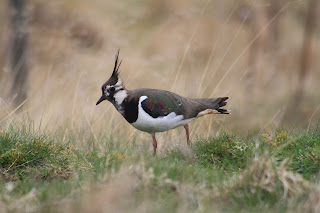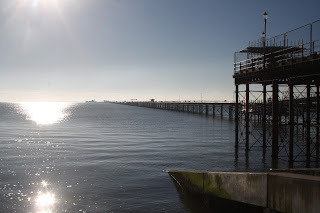Sitting beside my computer on a blue but chilly January day in the wilds of Essex, I cannot help but cast my mind back one more time, to Scotland, and its wildlife spectacles. In particular, to Emma and my trip to the Isle of Skye, its bays and Cuillin hills, the ragged mountains plunging into the, under an intemperate, grey and angry sky around the time of the Autumn equinox.
The East Coast of Scotland, where Skye sits, is something of a haven for
Raptors, but they are not always as conspicuous as one might hope. At first glance
this rugged place seems birdless. A couple of days into the trip, avoiding the near
constant ribbons of rain which drench the dramatic landscape on Autumn days, we
got our wallets out and paid a guy to take us to the birds. Andy of Skye
Wildlife Tours took us on a day long van tour of the island, using his expert
local knowledge to show us some of the birds which make this island famous. From
our first stop, we watched a white-rumped ringtail Hen Harrier coast along a
rain soaked glen, scanning for prey before disappearing from sight. Pairs of Golden
Eagles floated above the moorland, dark against the grey sky during gaps in the
rain. Rain isn’t good for raptors, preventing the thermals on which they ride
from forming. Perversely well camouflaged
on the ground, despite the golden shawl of feathers around their nape, in the
skies of Skye they are unmistakable, floating on long, broad wings. In their
pairs, the size difference the sexes show is remarkable. Females are huge.
Males are somewhat smaller, by up to a third, it seemed. This is a
characteristic shared by many raptors, which perhaps allows some niche differentiation,
minimising competition for food resources between the sexes as the females
pursue larger prey, or else simply maximises the surface area the female can
offer to her eggs for incubation. Sparrowhawks and Goshawks show this dimorphism
even more markedly. Persecuted and revered, often at the same time, down the
centuries, the West Coast, where deer stalking is a far more popular pastime than
grouse shooting which dominates in the Eastern Cairngorms, offers some sanctuary
from the residual persecution which some Golden Eagles still face. Across the
Northern Hemisphere, the Golden Eagle remains one of the most successful large
birds of prey, taking mammals off mountains and in winter, eating carrion at
carcasses, including those of deer felled by ‘sportsmen’ and deer managers. Where
the RSPB engages in deer control to protect early regrowth of Caledonian pine
forests, they still leave the gralloch and some of the carcasses as a winter
food source for these extraordinary, semi-mythic birds.
 |
| White Tailed Eagle, Isle of Skye |
Historically, the impact of persecution was even worse for Scotland’s other Eagle species. The White Tailed Eagle has faced local extinction. Sometimes called the White Tailed Sea Eagle, it is another year round resident of this unforgiving coastline. It enjoys, but is not tied to the coast, quite capable of hunting and thriving inland. It became extinct around the turn of the 20th century in Scotland, but a successful reintroduction programme using individuals from Norway, along the coast of which they can be surprisingly numerous, has enabled it to approach its historic numbers. We saw no less than 14 of these magnificent birds, huge outstretched wings resembling doors, the fabled flying barn door no less, on our van safari through Skye’s hills, a juvenile, identified by his not having a white tail, passing confidently just a few metres over our heads as we stood on one of the small piers there, on slow flapping wings, waders and ducks erupting in panic to keep away from this great predator. In more recent years, a reintroduction to the Isle of Wight in Hampshire has led to these birds soaring once again over Southern England, indeed, I have seen such an individual drifting over Essex, and famously one overflew the March for Nature in London in 2022. One hopes they will eventually look as at home on the South Coast of England as they do on the West Coast of Scotland.
 |
| White Tailed Eagle, Isle of Skye |
Our van day was completed by a range of waders, waterfowl and distant seabirds, as well as the obligatory red deer, watching us curiously from high hills, the inaccessible, to all but the most seasoned of human mountaineers, Black Cuillins, huge basalt Munroes plunging into the glens and into the wild Atlantic Ocean. Our closest encounter with White Tailed Eagles came on a boat trip from Portree, where we embarked on the Stardust despite the rain and tall sea, with remarkably low expectations. First, just a few minutes out, we met with another giant, the huge arching back of a five or so metre long, juvenile Minke Whale, who broke the surface a couple of times to the gasps of assembled onlookers before disappearing beneath the waves, disappearing into the murky depths. Gannets and Great Black Backed Gulls excitedly snatching the fish stunned by the wake of the mighty beast. But the boatman had another spectacular in store, as he threw a couple of dead fish, fishmonger discards, from the back of the boat. The birds reaction was not instant, the adult White Tailed Eagle waiting on a cliff, perhaps reluctant to get his feathers too wet in the rain and spray, but after watching the Gulls grab a couple, jealously kicked in, and down he came, stooping, wings swung back, on these easy pickings. He swung his big yellow talons forward and grabbed the fish off the water surface, easily, before climbing off, back to his clifftop perch. What a magnificent bird, and a magnificent encounter. The behaviour may not be fully natural, an opportunistic reaction to human activity, White Tailed Eagles do not typically grab fish off the sea like Ospreys, but it was certainly spectacular, to see such an awesome predator, and so close!
 |
| An Corran Megalosaurus Footprint. |
Also on Skye, and at Emma’s suggestion, we sought out and found a close encounter with one of the Eagle’s, and the gulls, mighty ancestors. In the mudstone of An Corran beach, we paid a visit to Skye’s Middle Jurassic period, and walked in the 160 or so million year old footsteps of a Megalosaurid theropod dinosaur, traces from deep prehistory. Its three toed footprints were clear, and clearly recalled those of birds in more modern muds. But in Megalosaurus, here was a predator to rival even the Eagles. A toothy biped, six metres nose to tail, and as tall as a tall man, Megalosaurus was quite likely something of an active predator upon the herbivorous Stegosaurs and Camptosaurs with which it shared its environment, it was the dominant predator of its time. The dinosaur-descended Eagles are its worthy successors, and it is sobering to reflect on how close these magnificent aerial hunters so nearly joined the Megalosaurus in extinction. But the eagles are recovering, they are spectacular, we saw them, and they are wonderful.
































